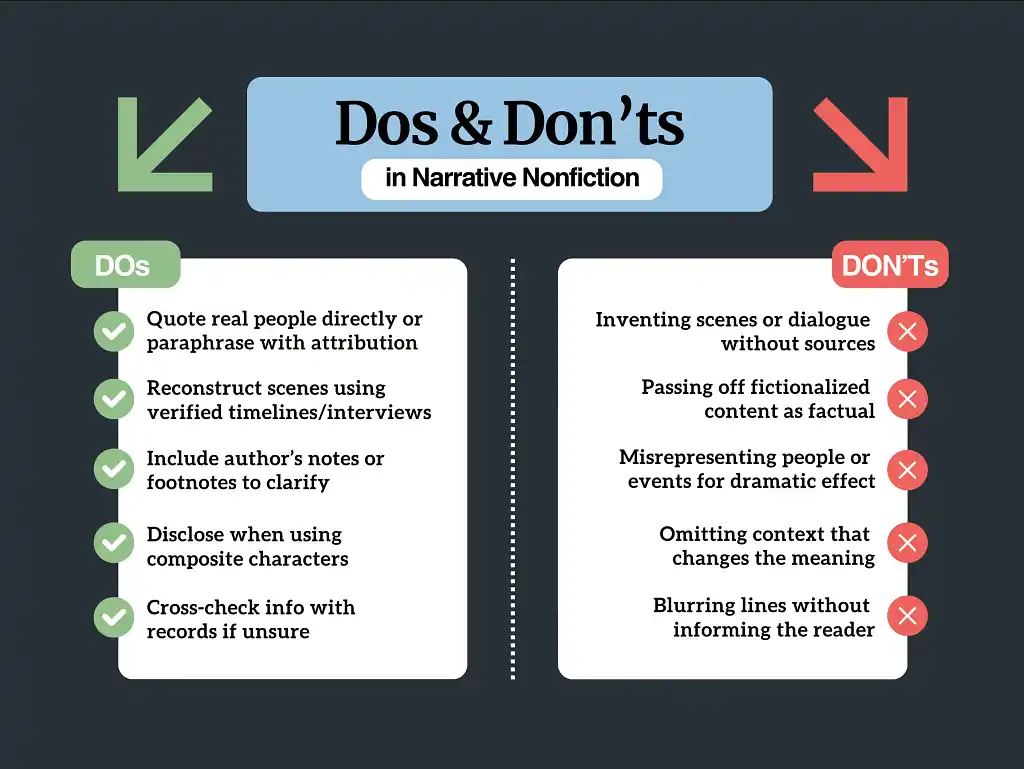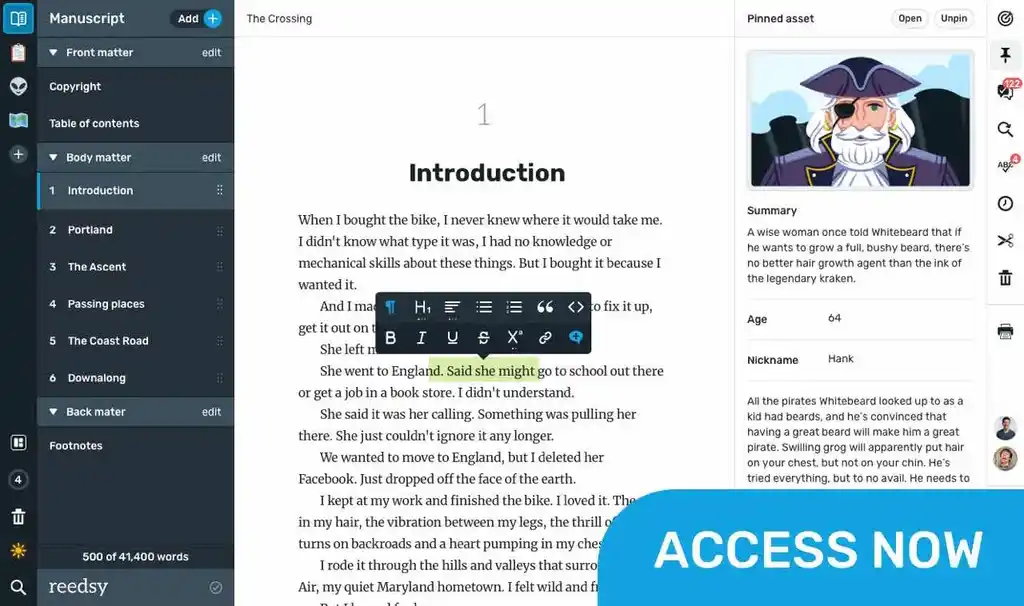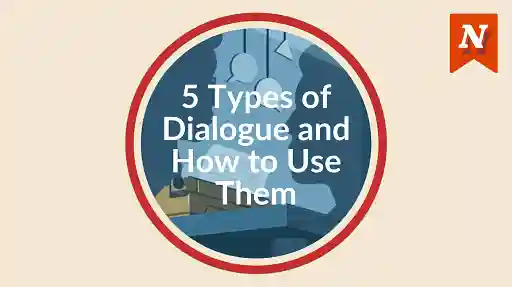Sometimes, the most unforgettable stories are the true ones — and narrative nonfiction is how they come alive. This category of nonfiction uses immersive storytelling techniques, like vivid settings and high emotional stakes, to communicate a nearly journalistic degree of truth. Basically, it tells real-life sagas without compromising on factual integrity or entertainment.
You’ll often see narrative nonfiction lumped in with creative nonfiction or memoir — but it remains its own distinct category. While all three are grounded in real events, their scope and focus set them apart.
Narrative nonfiction tells a true story about real people and experiences, often using literary techniques commonly found in fiction. Memoir, by contrast, focuses specifically on the author’s personal experiences or is narrated by the author on behalf of a subject. Finally, creative nonfiction is the broad umbrella that includes both of these, as well as other forms that may or may not follow a narrative arc (such as personal essays).
Let’s take a closer look at some common characteristics of narrative nonfiction, along with examples that show how they captivate readers.
1. Authentic, layered “characters”
One defining characteristic of narrative nonfiction is its cast of real people, who are portrayed as their true, complex selves. However, writers do use fiction-friendly techniques to “develop” them as characters — diving deep into their personalities, conflicts, motivations, and contradictions.
Writers must walk an ethical tightrope, representing people fairly without resorting to sensationalism or caricature. That means capturing the essence of their experience while also being mindful of privacy and accuracy. Here’s an example that achieves that.
Example: Behind the Beautiful Forevers by Katherine Boo
Because his family lacked the floor space for all of its members to lie down, Abdul was asleep on the gritty maidan, which for years had passed as his bed. His mother stepped carefully over one of his younger brothers, and then another, bending low to Abdul's ear. "Wake up, fool!" she said exuberantly. "You think your work is dreaming?"
Superstitious, Zehrunisa had noticed that some of the family's most profitable days occurred after she had showered abuses on her eldest son. January's income being pivotal to the family's latest plan of escape from Annawadi, she had decided to make the curses routine.
In this passage, Boo captures the lives of Mumbai slum residents in great detail. Zehrunisa’s fierce affection, superstitions, and her family’s aspirations all emerge in just a few lines. Her daily cursing ritual, while unusual, reflects a resourceful woman doing whatever she can for her family’s future.
Their struggles, rituals, and cramped home reveal the emotional texture of the family’s everyday reality. Rather than reducing them to symbols of poverty, Boo gives her subjects complexity, agency, and interiority: all hallmarks of strong character portrayal in narrative nonfiction.
What are composite characters in narrative nonfiction?
Composite characters combine traits and experiences from multiple real people into one fictional character. They're used to protect people’s privacy or streamline complex stories, but must always be disclosed to readers and grounded in research.
For example, Barack Obama acknowledged that the New York girlfriend in Dreams from My Father was a composite character based on multiple real people whose identities had to be protected.
2. Structure that mirrors fictional plots
Although rooted in fact, many narrative nonfiction works borrow familiar structures from fiction. For example, narrative nonfiction might follow a three-act arc, a hero’s journey, or even a Fichtean curve (which involves many successive crises).
Regardless of its exact structure, narrative nonfiction should strive to deliver plenty of rising tension/action, a climax, and a resolution. This sequence keeps readers emotionally engaged — and provides a useful framework for depicting real-life events.
Example: Killers of the Flower Moon by David Grann
One of the reasons I decided to structure the book this way, telling the story from three distinct vantage points, was to hopefully illuminate how hard it is to discern history as it is unfolding, especially when the perpetrators are trying to cover up what really happened. Only with time does more of the whole picture emerge. In the third chronicle, I document — based on a great deal of new information — that though the FBI caught several of the killers, there was a deeper and darker conspiracy that it never exposed.
— David Grann, author of Killers of the Flower Moon
This quote from David Grann refers to the suspenseful three-part structure he used in his book. Each part is presented from a different narrative perspective:
-
Mollie Burkhart and the Osage victims
-
FBI agent Tom White and his investigation
-
Grann himself, recounting his modern-day research
The result is a mystery/thriller-esque story arc, wherein new information continuously reshapes the reader’s understanding. Similar to actual thrillers like Gone Girl or Lucy Foley’s The Guest List, Grann’s Killers of the Flower Moon uses these different vantage points to reveal gripping new angles to the story.
And in true mystery/thriller fashion, Grann’s third part delivers the big reveal, exposing a wider conspiracy. Through its shifting perspectives, this structure delivers both suspense and historical insight — a balance that makes for highly effective narrative nonfiction.
3. Reconstructed dialogue and internal monologue
One of the most debated (and often misunderstood) features of narrative nonfiction is dialogue. Should narrative nonfiction writers include it? The short answer is yes — so long as it’s reconstructed from journalistic interviews, recordings, or credible memories.
Internal monologue is trickier to work with. The best narrative nonfiction draws from journals or personal accounts for voices that are clearly contextualized. Ultimately, the goal is to convey a sense of immediacy and realism without distorting the truth.
Example: In Cold Blood by Truman Capote
"I thought that Mr. Clutter was a very nice gentleman. I thought so right up to the moment I cut his throat."
This quote from Perry Smith appears twice in In Cold Blood — first during his initial confession, and again when Capote examines his psyche later in the book. This underscores how dialogue in narrative nonfiction can carry both factual weight and chilling emotional resonance.
In this case, Capote doesn’t paraphrase or filter Perry’s words. Instead, he lets the direct quote stand starkly, revealing the unsettling duality in Perry’s mindset. By preserving the character’s voice, Capote forces readers to confront this reality — illustrating how dialogue can reveal character complexity and deepen tension in narrative nonfiction.
4. Sensory detail and immersive settings
Ideally, narrative nonfiction doesn’t just recount events — it also places you in the midst of them. Vivid descriptions, atmospheric details, and sensory cues allow readers to connect with the setting, drawing them closer to the story.
Example: The Warmth of Other Suns by Isabel Wilkerson
The leaves were the color of sweet potatoes and of the summer sun when it sets. They had begun to fall from the branches and settle in piles at the roots of the elm trees. The leaves had begun to fall when Ida Mae and George walked into the cold light of morning for the very first time in the North.
Ida Mae and her family had ridden all through the night on the Illinois Central and had arrived, stiff and disheveled, in a cold, hurrying place of concrete and steel. People clipped past them in their wool finery and distracted urgency, not pausing to speak–people everywhere, more people than they had maybe seen in one single place in their entire lives, coming as they were from the spreadout, isolated back country of plantations and lean-tos.
Here, Wilkerson immerses readers through rich sensory detail; from the warm, earthy imagery of “leaves the color of sweet potatoes” to the brisk, metallic setting of the cold North. The sharp contrast captures the jarring dislocation and emotional shift Ida Mae and her family experienced. This is a great example of how setting in narrative nonfiction can evoke mood and character experience — indeed, not unlike in fiction.
5. Underlying meaning, reflection, and thematic depth
Narrative nonfiction asks bigger questions than just “What happened?”. It also delves into: Why did this happen? What does it mean? What’s the deeper truth beneath the facts?
Works in this category often weave together themes of identity, justice, trauma, or transformation, encouraging readers to reflect and emotionally engage with the story. When done right, readers should learn and feel something through narrative nonfiction.
Example: Between the World and Me by Ta-Nehisi Coates
Race is the child of racism, not the father. And the process of naming “the people” has never been a matter of genealogy and physiognomy so much as one of hierarchy. Difference in hue and hair is old.
But the belief in the preeminence of hue and hair, the notion that these factors can correctly organize a society and that they signify deeper attributes, which are indelible — this is the new idea at the heart of these new people who have been brought up hopelessly, tragically, deceitfully, to believe that they are white.
Although framed as a letter to Coates’ son, this book moves beyond personal narrative to interrogate systems of power and the constructed nature of race. Instead of simply recounting historical events, Coates reflects on the ideology behind racism — inviting readers to examine complex questions about identity, history, and justice. That’s the power of narrative nonfiction at work, with meaning and thematic depth integrated seamlessly into the story.
6. Research-driven yet intimate
Quite a few narrative nonfiction books also depend on rigorous research. Authors draw from sources like interviews, published records, archives, and sometimes more intensive investigative methods like FOIA requests or site visits.
But of course, facts presented without narrative rarely create a compelling reading experience. The human element is what transforms research into engaging storytelling.
Again, this is where writers must tread a fine ethical line. The research must be handled with transparency and respect, and without exploitation. Ideally, narrative nonfiction strives to honor real lives and represent real stories with integrity.
Example: Empire of Pain: The Secret History of the Sackler Dynasty by Patrick Radden Keefe
According to the Centers for Disease Control and Prevention, in the quarter century following the introduction of OxyContin, some 450,000 Americans had died of opioid-related overdoses. Such overdoses were now the leading cause of accidental death in America, accounting for more deaths than car accidents — more deaths, even, than that most quintessentially American of metrics, gunshot wounds. In fact, more Americans had lost their lives from opioid overdoses than had died in all of the wars the country had fought since World War II.
In this extensive investigation into the Sackler family and Purdue Pharma, Keefe lays out the devastating scale of the opioid epidemic.
But he doesn’t simply reel off the numbers. By comparing these deaths to casualties from car crashes, shootings, and every war since WWII, Keefe contextualizes the full human cost of the epidemic. Drawing on data from an authoritative source in healthcare (the CDC), he frames the crisis in familiar and sobering terms. It’s this alloy of thorough research and human sensitivity that makes the narration really hit home.
How much “creative license” is allowed in narrative nonfiction?
You can use literary techniques (like starting in medias res or building a certain atmosphere) to enhance your storytelling — and you can even “reconstruct” memories and use composite characters, as noted above. However, you should never alter clear-cut facts or intentionally mislead the reader. Always be transparent about your sources and methods, and do your best to convey the truth with the information you have.
Here are a few things to be mindful of while writing narrative nonfiction:
Narrative nonfiction is a genre that tugs at both the heart and the mind. It engages readers like fiction but enlightens like journalism, turning real-life accounts into unforgettable literature. Whether it's a tale of scientific discovery, personal resilience, or social injustice, narrative nonfiction invites us to think for ourselves, feel fully, and understand the world more clearly.










